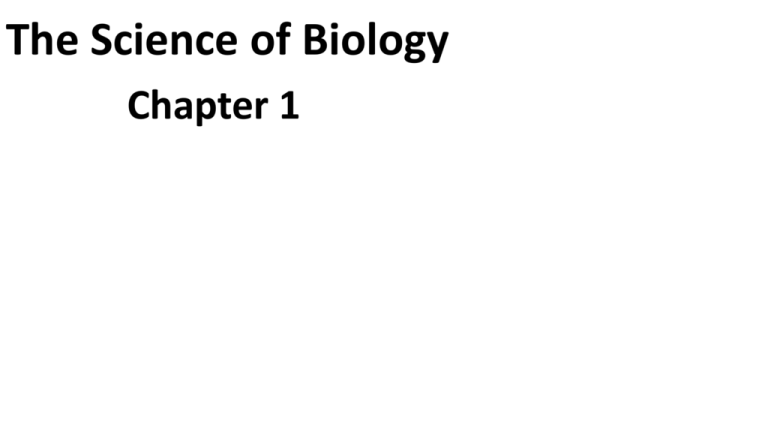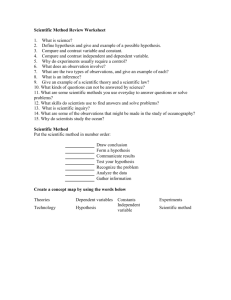The Science of Biology
advertisement

The Science of Biology Chapter 1 Ch 1.1-What is Science? - An organized way of gathering evidence about the natural world - Goals: 1) Provide natural explanations for events in the natural world 2) Use those explanations to understand patterns in nature 3) Make useful predictions about natural events “Think something that nobody has thought yet, while looking at something that everybody sees”— Arthur Schopenhauer 1. Make an Observation Scientific Methodology 2. Ask a Question Types of Observations: 1) Qualitative: using your senses (sight, smell, sound, touch, taste) 2) Quantitative: using instruments and tools (rulers, beakers, graduated cylinders, etc) Scientific Methodology 1. Make an Observation 2. Ask a Question 3. Make an Inference 4. Form a Hypothesis Inference: A logical interpretation based on what scientists already know (General) Hypothesis: A scientific explanation for a set of observations that can be tested in ways that support or reject it (More specific) Inferences and Hypotheses - Observation: Larger species of barnacles are found lower in the intertidal than the larger species of barnacles - Question: Why are barnacle species that are different sizes found in different areas? - Inference: There is something that influences where a species of barnacles lives - Hypothesis: Barnacle location is influenced by predation (or many other factors) Scientific Methodology 1. Make an Observation 2. Ask a Question 3. Make an Inference 4. Form a Hypothesis 5. Test the Hypothesis with Controlled Experiments Controlled Experiments - Keep track of factors, or variables, that naturally change - Examples: temperature, light, time, etc - Independent Variable: the variable that is deliberately changed (manipulated variable; the variable that will produce an effect) - Dependent Variable: the variable that is observed and changes in response to the independent variable (responding variable; the variable that depends on the manipulation of the other variable) - Control Group: the group that is not treated with the independent variable but is exposed to all other conditions Scientific Methodology 1. Make an Observation 2. Ask a Question 3. Make an Inference 4. Form a Hypothesis 5. Test the Hypothesis with Controlled Experiments 6. Collect and Analyze Data Data Collection-Tools Data Collection-Graphs Line Graph Bar Graph Scatter Plot Pie Chart Scientific Methodology 1. Make an Observation 2. Ask a Question 3. Make an Inference 4. Form a Hypothesis 5. Test the Hypothesis with Controlled Experiments 6. Collect and Analyze Data 7. Develop Conclusions Ch 1.2: Science in Context Asking the right kinds of questions 1) Curiosity 2) Skepticism 3) Open-Mindedness 4) Creativity 5) Identifying practical problems 6) Using advances in technology Communicating Results - Peer Review - Scientific Journals - New Ideas and Questions - Replication of Results Scientific Theories - Well-tested explanations that unify many observations and hypotheses - Enable scientists to make accurate predictions about new situations - Examples: - Gravitational Theory - Evolutionary Theory - Cell Theory Science and Society - How does science relate to us? - Make a list of any current scientific issues that directly influence you - We cannot study science without understanding its role in society What is science and what isn’t? - Ethics and Morality - How life works - Applying scientific knowledge - Bias: a particular preference or point of view that is personal, rather than scientific Who makes decisions about laws and public policy? Ch 1.3 Studying Life Is it alive? 8 Characteristics of Living Things 1. Living things are based on a universal genetic code. 2. Living things reproduce. 3. Living things grow and develop. 4. Living things respond to their environment. 8 Characteristics of Living Things 5. Living things maintain a stable internal environment. 6. Living things obtain and use material and energy. 7. Living things evolve. 8. Living things are made of cells.





